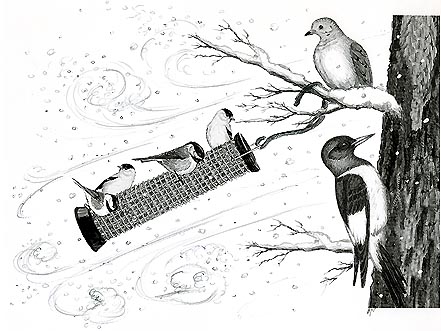
Dear Bird Folks,
Before we get to my question, you should know that I now read your column each week before I look at the obituaries. (That’s a compliment by the way.) During the height of last month’s blizzard, when the winds were strong enough to toss our lawn furniture around, the birds fed on the ground by our feeders and not a feather fluttered. Why did the lightweight birds not get blown away?
-JC, West Yarmouth, MA
Thanks JC,
Thanks for putting me ahead of dead people. It’s a good move on your part, because I’m a pretty busy guy, while that obituary crowd has extra time on their hands. Although I’ve never spoken to any of them directly, I’d bet they won’t mind waiting for you to read a column or two before you get to them. They’re good like that.
It is amazing that birds are able to stay out in those punishing winds or just about any kind of winds since they are so ridiculously light weight. Feeder birds such as chickadees or goldfinches only weigh 1/3 of an ounce each. Yes, one third of an ounce. That means you could put three chickadees in an envelope and mail them, First Class, for only 37¢. I’m not suggesting that you try, but if you do, just remember to write “hand cancel” on the envelope.
Birds deal with high winds in several different ways. One of the ways that they handle wind is just as you observed, they stay low and feed off the ground. Even traditionally non-ground feeding birds eat low to avoid being blasted by the winds. They also use natural barriers for protection, hunkering down on the leeward side of thickets, tree trunks or slow moving fat guys. One lady told me about a Mourning Dove that sat, throughout the entire storm, on the protected side of her feeder. The traditionally wimpy dove aggressively defended its spot from all other birds, not because it was hoarding food, but because it didn’t want to give up that balmy location.
As odd as it may seem, facing strong winds head on is another defense against storm damage. Most people know that facing into the wind helps birds with their take off, but it also helps them survive. Bird’s feathers are arranged to allow head winds to flow smoothly around them, whereas tail winds ruffle and catch feathers. Cold winds, that blow under a birdÕs protective layer of feathers, may cause a critical loss of heat. A cold blast of air from behind can produce a pretty good chill, as most women in skirts and Scotsmen will tell you.
Songbirds’ ability to cling is also important to their survival. During the height of that nasty storm, I had a flock of goldfinches eating off my thistle feeder. (Do you remember how unbelievably light goldfinches are? I told you a few paragraphs ago. Do you remember? Well, you are going to have to reread it yourself because I’m not writing it again.) The howling wind was blowing my thistle feeder perfectly horizontal, but the finches easily stayed on the perches and continued to eat as if nothing unusual was happening. How could they do that? Perching birds have these crazy long leg tendons that run from the back of their knees, past their ankles, to the tips of their toes. When a bird hunkers down, the tendons pull their claws closed. The tiny birdÕs toes are locked onto the perch so tightly that you would need the Jaws of Life to get them off it.
Land birds are less affected by wind than seabirds. Seabirds are totally exposed in the open ocean, having very little to hide behind, except each other. Weak flyers, seabirds are often blown onto land by storms. Many people reported finding “penguins” walking around in their backyards after the blizzard. Most of these reports turned out to be dovekies or murres, small black and white seabirds that do look and walk like penguins. Once they are out of the water, these pengiun-like birds are in trouble because they can’t take off from land. The lucky birds were rescued and taken back to the ocean, but sadly many others didn’t survive. Most simply starved to death or were killed by dogs or other predators. And some were eaten by hungry tourists who had been trapped in their hotels all weekend.
Of course the blizzards are tough on all birds, but it’s probably not the wind that causes the greatest problems for land birds. The deep snow that covers the food is much more of a threat than the strong winds.
Thanks for the question JC. Now you can continue on to the obituaries. However, if you see my name there, don’t tell me. I have plans for the weekend.